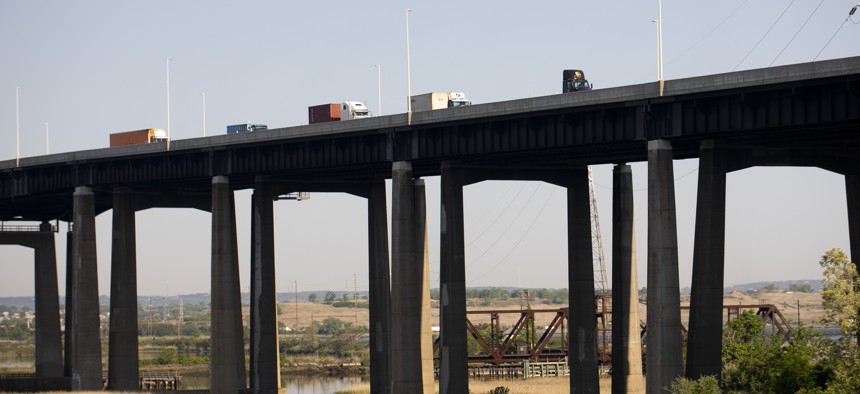Financing Plan for Infrastructure Agreement Called into Question

This May 18, 2021, photo shows traffic along a bridge as seen from a train in New Jersey. AP Photo/Jenny Kane
Finance experts say the plan to pay for the infrastructure proposal, in part by clawing back unspent Covid relief funds, is unlikely to cover the full cost.
The White House and a bipartisan group of senators heralded agreement on an infrastructure package framework as a major breakthrough. But policy and finance experts say the real breakthrough will come if lawmakers find a way to pay for the proposal.
President Biden has promised not to raise taxes on people earning less than $400,000 while senators said the infrastructure proposal would not include new taxes. Details about the financing of the $1.2 trillion proposal are limited, and experts have questioned whether the mishmash of possible funding sources outlined in a White House proposal will be enough to pay for the project.
“They’ve settled on a grab-bag of narrow revenue raisers and promised spending reductions that likely never will happen,” wrote Howard Gleckman, a senior fellow in the Urban-Brookings Tax Policy Center at the Urban Institute, in a critique of the spending proposal. “If they do, they’ll generate far less than the plan’s backers hope.”
Two financing possibilities under consideration rely on redirecting unused unemployment insurance funds and repurposing unspent Covid relief money allocated in 2020 legislation.
A document provided to lawmakers and obtained by reporters outlines an estimated $584 billion in offsets, including $80 billion offset through repurposing Covid funds and $25 billion offset by redirecting unused unemployment funds from states that terminated the benefits early.
But finance experts say it isn’t that simple.
“Just because the money hasn’t been spent doesn’t mean it’s usable,” said Marc Goldwein, the senior vice president of policy for the Committee for a Responsible Federal Budget.
Repurposing money could require proactive policy changes to be enacted by Congress or implemented by the Biden administration, he said.
For instance, the Families First Coronavirus Response Act provides states a 6.2% increase in their share of federal Medicaid spending so long as the national public health emergency remains in place. The public health emergency is expected to be renewed so that it remains in place through at least the end of the year. The administration would have to end the public health emergency early in order to recoup the Medicaid savings and put it toward infrastructure funding, Goldwein explained.
Several states have ended expanded unemployment benefits, which offered $300 weekly payments financed by the federal government. The supplemental payments were meant to be available through September, but because some states cut the benefits early there is an estimated $25 billion that will not be spent.
Using the $25 billion on infrastructure rather than unemployment amounts to budgeting “trickery” rather than a true savings, said Andrew Stettner, a senior fellow at the Century Foundation.
“Congress isn’t doing anything. They just overestimated how much they would spend and now they are using the savings,” he said.
There are some pots of money that likely have more left than others, including public health funding for Covid-19 testing and tracing efforts, education funding and funding allocated for state and local governments, he said.
But Goldwein said, “the package they have is not going to save nearly the amount they think it is.”
Outside of the bipartisan infrastructure framework, Republican lawmakers have also proposed repurposing money that was allocated through the American Rescue Plan Act but will not be spent in 2021. The Congressional Budget Office has identified more than $700 billion in ARPA funding that will be spent in 2022 and beyond. That includes part of the $350 billion direct aid provided to state and local governments. State and local officials are actively pushing back against calls to repurpose that funding.
Andrea Noble is a staff correspondent for Route Fifty.
NEXT STORY: Lawmakers mull fixes for state and local tech challenges





